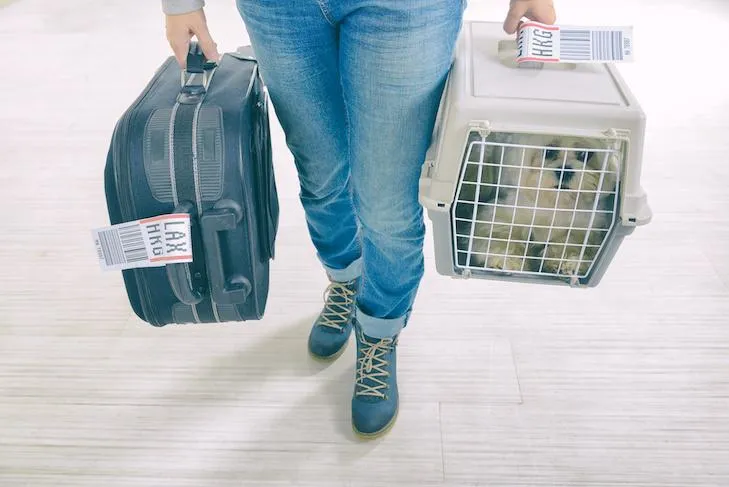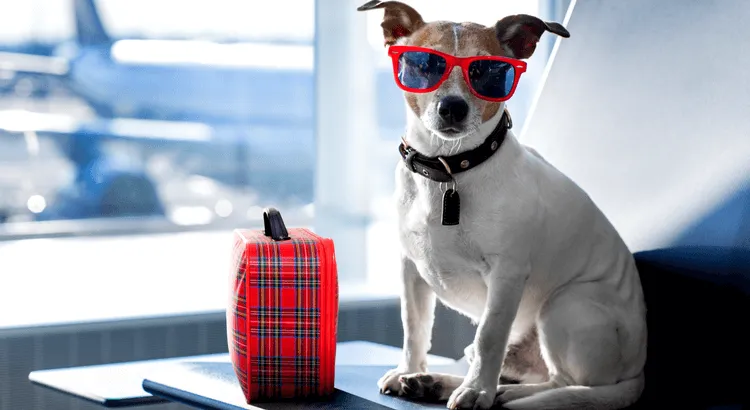A Comprehensive Guide to Flying with Your Large Dog
If you’ve ever wanted to take a vacation with your furry best friend but weren’t sure how to bring Fido along on the plane, this article is for you. From navigating airline regulations to preparing your pup for the journey, we’ll cover all the bases to help you and your big dog fly with ease.
Check Airline Policies
The first step is checking your airline’s pet policy to see if they allow large dogs in the cabin and what size restrictions they have. Most major airlines allow dogs under 20 lbs in the cabin for a fee, but require animals over that weight to be checked as cargo. Make sure to inquire about any other requirements like health records, vaccinations, kennel size, and advance notice needed. It’s also smart to ask about limitations on certain breeds that may be restricted.
Book Flights Early
Booking flights well in advance is key when bringing an animal, as space is limited in both the cabin and cargo hold due to safety and animal welfare regulations. The earlier you reserve, the better chance your large pup will have a spot. Airlines may fill up fast around holidays too, so plan accordingly. It’s also a good idea to confirm your dog’s booking at least 72 hours before departure in case changes are needed.
Choose the Right Kennel
Airlines require dogs be transported in an approved hard-sided kennel that is well-ventilated and leak-proof in case of accidents. For large dogs, look for a carrier at least 18″ high so they can stand up and turn around comfortably. Practice opening and closing the kennel door indoors before your big day. On the day of travel, clearly label the outside of the crate with your contact info in case it gets separated from you en route.
Prepare Your Pup
It’s crucial to get your dog accustomed to their kennel before flying. In the months leading up, feed them in the kennel with the door open and closed to positive associations. Slowly work up to having them rest inside for longer periods with treats and praise. Consider enrolling in a calming canine class too. On travel day, adhere to their normal feeding/potty schedule as best as possible amid the chaos.

Pack Essentials
In addition to their kennel, be sure to pack important items like favorite toys or blankets with your dog’s familiar scent to ease anxiety. Also don’t forget ID tags, vaccination records, travel water bowl, poop bags, and any medications like sedatives or supplements if flying tends to stress them out. It’s worth bringing extras in case baggage gets delayed. Lastly, provide an extra leash and collar in your carry-on in case their travel gear is mishandled.
Sedation May Help
Consult your vet about using light sedatives for flights if your dog tends to be nervous. Getting them accustomed to medication in controlled situations first is recommended versus using them for the first time on the plane. Make sure to bring written permission from your vet and keep meds easily accessible during inspection. However, be aware sedated animals may not always be accepted for safety reasons. Know your dog best in making this call.
Drive Them to the Airport
Rather than subjecting your dog to a possibly scary car ride with an unfamiliar driver, consider driving them yourself if possible. This allows you to stay calm and confident for their sake on what’s likely an already high-anxiety day. If you must take a taxi or shuttle, see if parking is available so you can comfortably escort them into the terminal and to the check-in counter.
Prepare for Inspections
Expect airline staff to give your dog’s health documents and kennel a once-over before allowing it onboard. Make sure paperwork is complete and easily accessible. Open the crate door partly so employees can see your pup is settled inside calmly during screening. Answer any questions politely and be ready to leave the area promptly once cleared. Ensure cold weather gear or medical records are also on hand for longer connecting flights if needed.
Follow Check-In Procedures
Comply fully with check-in deadlines and instructions to avoid issues with your dog’s travel plans. Arrive early enough that you aren’t rushed. Once tags and travel documents are checked, you’ll likely turn your kennel over to airline staff. Calmly bid farewell to your pup with a “goodbye” command for legal reasons and promptly leave the area. Try not to linger, as this separation period is stressful on dogs that pick up on human energy, even from afar.

Prepare for Arrival
Anticipate your dog may be shaken up from the experience, so have water, a leash and potentially calming aids ready upon arrival. Follow instructions carefully to claim them from cargo hold. Expect delays if flights are behind schedule too. Be soothing, calm and refrain from punishing fearful reactions in favor of praise and affection to build their confidence again. Once safely home, give plenty of love and down time to fully decompress from travel stress.
Consider Alternatives
If flying with a large nervous dog seems like too much, look into driving yourself or using a professional pet transportation service for longer hauls instead. Back seat crates and frequent stops work well for many dogs. You could also board them at your destination in advance through Rover or a trustworthy local kennel. Think about what’s least stressful overall for your pup based on their personality before committing to flights. Their comfort should be the top priority.
In summary, flying with big dogs is certainly possible with advance planning and care, but not without challenges. From my experience volunteering at a shelter, I’ve seen how travel stress can negatively impact certain anxious pooches for days. It’s important to thoroughly assess your dog’s tolerance for new situations and crowds before subjecting them to the rigors of air travel. Their health and happiness should come before any vacation desires of our own. With patience and the right precautions though, you can give your furry best friend the flying experience of their lives too. Safe travels to all pet parents and pups out there!
Tips for Bringing Your Big Dog On a Plane
| Requirement | Details |
|---|---|
| Vaccinations | Must be up to date on rabies, distemper, adenovirus 2 (hepatitis), and parvovirus vaccines. |
| Health certificate | Vet must sign off that your dog is healthy to fly within 10 days of flight. |
| Crate | Hard-sided, ventilated crate specifically sized for your dog that is large enough for them to stand up and turn around in. |
| ID collar | Dog must wear ID collar with tags containing your name and contact info at all times during travel. |
| Training | Dog should be crate trained and comfortable being confined for extended periods. |
FAQ
-
How early should I get to the airport with my dog?
The airline recommends arriving at least 2 hours before your scheduled departure time when traveling with a dog. This gives you plenty of time to check in, go through security, and get your furry friend settled into his crate or carrier. Better to get there a little early than risk being late!
-
What paperwork do I need for my dog?
You’ll need your dog’s health certificate signed by your vet, proof of vaccinations including rabies, and the airline may require a copy of his registration too. Basically, have all your pup’s important docs in one place so check-in goes smoothly. Don’t leave home without ’em!

-
Where can my dog sit on the plane?
Most airlines require dogs to stay in an approved travel crate that fits under the seat in front of you. However, on some flights small dogs may be allowed to stay in a carrier in your lap. But is it fair to ask a big Lab to sit on your legs for hours? Maybe a crate is better for a longer trip.
-
What size crate do I need?
The crate should be large enough for your dog to stand up and turn around in, but not too big it won’t fit under the seat. Most airlines provide crate size guidelines on their website, or you can ask when booking. I once got an illegal-sized crate through and it was kind of awkward! Better to follow the rules.
Is it safe to fly with my big dog?
For the most part, most major airlines have decades of experience transporting canine passengers with few problems. Nevertheless, turbulence or other issues could startle your pup. As long as you follow guidelines, your dog should be fine. At the same time, flying isn’t effortless for people either! I’m sure Fido would rather be home with you on the couch.
What if my dog is anxious?
Some dogs get pretty freaked out by the noise and motion of flying. Thankfully there are things you can do to help an anxious flyer feel more at ease. Ask your vet about calming treats or natural anxiety relief supplements. Bring favorite toys or chew items. Play soothing music or white noise on your phone. With a little preparation, even nervous Nellie should make it through the trip okay.
Can I bring other items for my dog?
Most airlines allow you to bring small bags with essentials like water, food, blankets, toys and poop bags. But check guidelines – some have size limits on carry-ons. It’s also a good idea to label everything clearly in case items get mixed up. I once left Fido’s frisbee at the airport by mistake! Oops. At least he had his favorite chew bone to keep him company instead.

